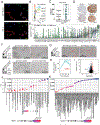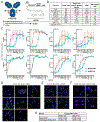A proteogenomic surfaceome study identifies DLK1 as an immunotherapeutic target in neuroblastoma
- PMID: 39454577
- PMCID: PMC11560519
- DOI: 10.1016/j.ccell.2024.10.003
A proteogenomic surfaceome study identifies DLK1 as an immunotherapeutic target in neuroblastoma
Abstract
Cancer immunotherapies produce remarkable results in B cell malignancies; however, optimal cell surface targets for many solid cancers remain elusive. Here, we present an integrative proteomic, transcriptomic, and epigenomic analysis of tumor and normal tissues to identify biologically relevant cell surface immunotherapeutic targets for neuroblastoma, an often-fatal childhood cancer. Proteogenomic analyses reveal sixty high-confidence candidate immunotherapeutic targets, and we prioritize delta-like canonical notch ligand 1 (DLK1) for further study. High expression of DLK1 directly correlates with a super-enhancer. Immunofluorescence, flow cytometry, and immunohistochemistry show robust cell surface expression of DLK1. Short hairpin RNA mediated silencing of DLK1 in neuroblastoma cells results in increased cellular differentiation. ADCT-701, a DLK1-targeting antibody-drug conjugate (ADC), shows potent and specific cytotoxicity in DLK1-expressing neuroblastoma xenograft models. Since high DLK1 expression is found in several adult and pediatric cancers, our study demonstrates the utility of a proteogenomic approach and credentials DLK1 as an immunotherapeutic target.
Keywords: DLK1; antibody-drug conjugate; cancer; immunotherapy; mass spectrometry; neuroblastoma; surfaceome.
Copyright © 2024 The Author(s). Published by Elsevier Inc. All rights reserved.
Conflict of interest statement
Declaration of interests F. Zammarchi, K. Havenith, and P.H.v.B. are or were employed by ADC Therapeutics at the time the work was conducted and hold or previously held shares/stocks in ADC Therapeutics. The following patent is held: WO2018146199A1.
Figures




Update of
-
A proteogenomic surfaceome study identifies DLK1 as an immunotherapeutic target in neuroblastoma.bioRxiv [Preprint]. 2024 Jan 7:2023.12.06.570390. doi: 10.1101/2023.12.06.570390. bioRxiv. 2024. Update in: Cancer Cell. 2024 Nov 11;42(11):1970-1982.e7. doi: 10.1016/j.ccell.2024.10.003. PMID: 38106022 Free PMC article. Updated. Preprint.
References
MeSH terms
Substances
Grants and funding
- R01 CA237562/CA/NCI NIH HHS/United States
- F31 CA225069/CA/NCI NIH HHS/United States
- U01 CA199287/CA/NCI NIH HHS/United States
- R35 CA220500/CA/NCI NIH HHS/United States
- R01 CA204974/CA/NCI NIH HHS/United States
- R03 CA230366/CA/NCI NIH HHS/United States
- U01 CA263957/CA/NCI NIH HHS/United States
- T32 CA009140/CA/NCI NIH HHS/United States
- U01 CA199222/CA/NCI NIH HHS/United States
- R37 CA282041/CA/NCI NIH HHS/United States
- U54 CA232568/CA/NCI NIH HHS/United States
- CGCATF-2021/100014/CRUK_/Cancer Research UK/United Kingdom
- OT2 CA278687/CA/NCI NIH HHS/United States
LinkOut - more resources
Full Text Sources
Medical

